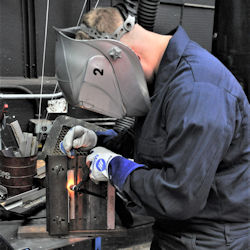Control Measures For Preventing Fires
Eliminate fire and explosion hazards by removing or reducing combustible or explosive materials or vapors, and by preventing them from accumulating.
The methods for making a space safe for welding, and the tests used to ensure a space is free of fire and explosion hazards, should be the responsibility of a welding supervisor.
Combustible Material: Wherever there are floor openings or cracks in the flooring that you cannot close, you should take precautions so no readily combustible materials on the floor below are exposed to sparks that might drop through the floor. Use the same precautions for cracks or holes in walls, open doorways, and open or broken windows.
Combustible Covers: Never weld on metal partitions, walls, ceilings, or roofs that are covered with combustible materials, or on walls or partitions made of combustible sandwich-type panels.
Relocation of Combustibles: If possible, relocate all combustibles at least 35 feet (10.7 m) from the work site. When relocation is not possible:
- protect combustibles with flame-proofed covers, or
- shield combustibles with metal or asbestos guards or curtains.
Floors: Where combustible materials such as paper clippings, wood shavings, or textile fibers are on the floor, sweep the floor clean within a radius of 35 feet (10.7 m). In addition:
- If floors are combustible, keep them wet, covered with damp sand, or protected by fire-resistant shields.
- Protect workers operating arc welding or cutting equipment from shock where floors have been wet down.
Ducts: Protect or shut down ducts and conveyor systems that might carry sparks to distant combustibles.
Combustible Walls: Where cutting or welding is done near walls, partitions, ceilings or roofs of combustible construction, provide fire-resistant shields or guards to prevent ignition.
Non-combustible Walls: If you need to do welding on a metal wall, partition, ceiling, or roof, prevent ignition of combustibles on the other side by relocating them, if possible. Where you are not able to relocate the combustibles, be sure to provide a fire watch on the opposite side from the work.
Pipes: Do not cut or weld on pipes or other metal in contact with combustible walls, partitions, ceilings or roofs if the work is close enough to cause ignition by conduction.
Fire Extinguishers: Position suitable fire extinguishing equipment and maintain it in a state of readiness for instant use. Depending on the nature and quantity of the combustible material, fire-extinguishing equipment may consist of the following:
- Pails of water
- Buckets of sand
- Hoses
- Portable extinguishers
Knowledge Check Choose the best answer for the question.
3-8. What is the recommended minimum distance to relocate combustibles from a welding area?
You forgot to answer the question!

